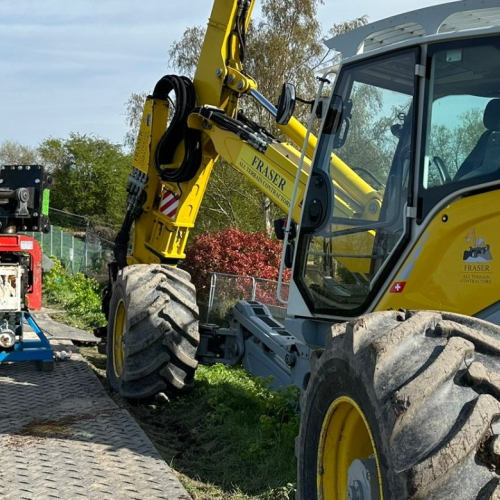
Rother Tidal Walls East spider excavator success
Our team working on the Rother Tidal Walls East project have been working to raise the existing embankments for 6.5km along the River Rother, to increase flood protection.
Most of the embankment raising is achieved by adding clay to the crest and landward side of the existing profile, however the team faced challenges at Kings Avenue, due to the limited space for construction and no space for widening the embankment. Instead, the team installed a 5m-deep steel sheet pile wall through the embankment crest using, for the first time, a "spider" excavator to install the piles and overcome the site's constraints and challenges.
A traditional construction method was originally envisaged for constructing the sheet pile walls. This included squeezing a significant stone temporary piling platform into the working corridor, to provide a robust level working area for a conventional “tracked” piling rig. However, as the project progressed and local constraints became better understood, it became evident that constructing the temporary platform would be more challenging and costly than installing the sheet pile wall itself. Additionally, it posed a significant carbon burden on the project.
The team overcame the piling platform challenge by removing it all together. Extensive research and collaboration with the plant supply chain and temporary works designers led to the discovery that a 12-tonne “spider” excavator, like the Menzi Muck M540, could be used without the need for an engineered platform. This type of excavator not only stabilises itself on the embankment slope without an engineered platform, but also has the power to lift and drive a 5m-long steel sheet pile, making it ideal for the Kings Avenue site. This marks the first time this type of excavator has been used in this way. The flexibility and stability of the spider excavator, equipped with four independent wheels and four out-riggers, enables it to achieve piling outputs which are almost the same as traditional methods. The increased hire cost of the spider excavator was easily justified by the significant savings resulting from eliminating the need for the platform.
The team made further significant cost and carbon savings by instigating a design change for the capping beam, replacing reinforced concrete with a steel section that could be lifted onto the wall by the spider excavator in between driving piles. Alongside the use of the spider excavator, this provided significant benefits, including:
- 65% cost reduction
- 82% decrease in carbon emissions compared to the original plan
- Reduced temporary works – less cost, carbon, duration, safety risk and environmental impact
- Reduced interface and land purchase from adjacent landowners
- Greater flexibility on access and construction sequence
- Ability to multi-task: a quick change of attachment allows excavation and auguring thus reducing the impacts of obstructions and vibration
- Ability to install sheet piles in places unreachable by conventional piling plant.
The team were presented with changing ground conditions this meant that the embankment surface was likely to be comprised and ‘ruts’ created if the original method of distributing piles with the spider excavator was followed. The team stood down the piling gang, so the methodology of the pile distribution was re-evaluated. Looking to different disciplines within the construction industry (steel frame construction), a remote-controlled electric tracked carrier 4000 PRO was proposed as a possible solution to distribute piles. This further innovation was successfully trailed, preventing the spider excavator from rutting the embankment with frequent trips to collect sheet piles.
The introduction of the remote track not only mitigated the initial stand down period, but it also improved the programme by completing three days early. Further analysis of the programme revealed a 43% programme saving by removing the stand down period and prolongation due to staff changes.
To find out more about the innovation taking place at Rother Tidal Walls East, and to see the spider excavator in action, watch our video below.